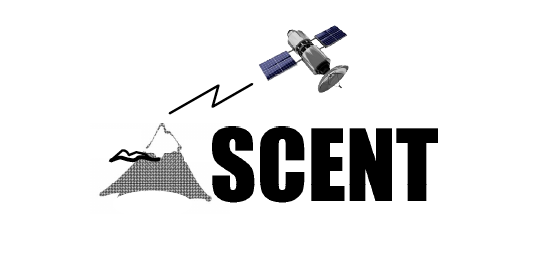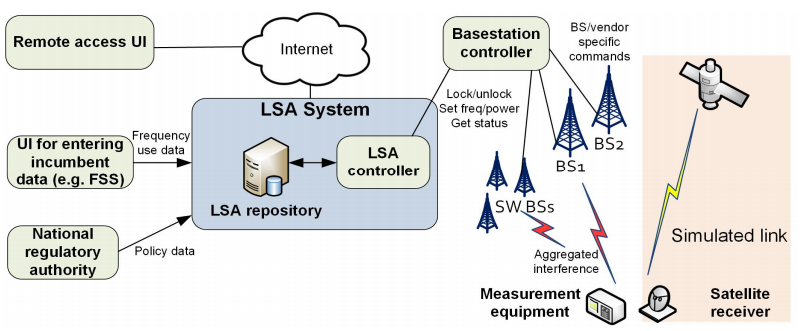
-
StatusCompleted
-
Status date2018-07-09
-
Activity Code3A.077
The applicability of the licensed shared access (LSA) concept in satellite/terrestrial scenarios is studied and validated with system level demonstrations. Specifically,
- A proof-of-concept testbed is designed and implemented. The testbed exploits efficiently frequency-sharing scenarios between 5G satellite and terrestrial components taking into account realistic network traffic dynamics.
- The combined use of LSA and other interference mitigation techniques to guarantee interference protection and QoS for
- satcom services are examined.
- Reference implementations of LSA vs. non-spectrum sharing approaches and centralised vs. distributed database-enabled LSA architectures are compared.
- Robust procedures and protocols between involved incumbent and challenger operators to guarantee coordinated frequency sharing taking into account the terrestrial and satellite network’s traffic dynamics are validated.
- Cost efficient and technically effective spectrum sharing between 5G satellite and terrestrial component for different verticals are proposed.
Finding and understanding the protocol bottlenecks in a sharing scenario when a high latency satellite connection is involved remains a challenge. The maximum tolerances allowed for the protocols, adjustable key protocol parameters, and development of robust protocols and procedures between incumbent and challenger operators are of main concern. The operation and management systems in the telecom domain are vendor specific and typically somewhat inflexible. Currently, the integration of LSA to SatCom network management system is still an open issue. Therefore, understanding which functionalities a satellite element introduces and how it should be integrated to the overall infrastructure is essential.
The results of the project show how to enable satellite networks to operate with shared spectrum resources in future expansion opportunities. Especially, the results can be used to guide the ground and space segment development when implementing the proposed sharing techniques as well as experiments to validate them further.
Broad state-of-the-art review on spectrum sharing techniques was made and selection of the most suitable ones done in the beginning. The work focused then on defining the LSA architecture and testbed for 5G pioneer bands, assessing also criticalities of operators. The developed testbed allows comparative evaluation of the proposed techniques, using LSA to control terrestrial system in the defined sharing scenarios. In addition, the developed simulation models allow studying how the satellites could access the terrestrial radio frequency bands. The overall testbed can be used in the development of coexisting, cooperating or integrated satellite-terrestrial communication systems.
The LSA system is in the central part of the architecture. It includes LSA repository and LSA controller. User interface (UI) is used to provide the incumbent data to the repository. The testbed can use data from the regulator delivered in the form of an excel table, for example.
In the first option, the LSA system sends commands to terrestrial cellular base stations (BS) through the BS controller, which converts them to a BS and vendor specific commands. The BS can be either real or emulated. In case of a real BS, measurement devices can be used to determine the interference level at the satellite receiver. The overall target is to keep the interference levels acceptable. The measurements were used to verify interference computation models in a selected case.
In the second option, the cellular system is protected from harmful interference from a satellite by using protection zone allowing the satellite to operate only under certain conditions. In our case, we limit the transmission power of the satellite. The proof-of-concept simulations were run in STK simulator. The ns-2 network simulator was updated to support zones for multi-beam satellites. In addition to simulation mode, ns-2 can be run in real-time emulation mode to support zone input from external systems, e.g., LSA system.


The progress was monitored with four milestones. At first, the use cases, network traffic models, interference environments and the architecture of the LSA system were defined. The critical elements and development risks were analysed. The roles, relationships and interfaces of involved operators were defined. These results were evaluated in the preliminary system design review (PSDR). Secondly, the LSA testbed was developed and validated for the LSA testbed review (LTR). It was followed by system level testing and proof-of-concept demonstration (PD). Finally, a technology roadmap was prepared and recommendations for future work were presented for the final review (FR). The duration of the project was extended from 24 to 30 months in order to cover a short interference measurement campaign as CCN.
The project developed a functional testbed that has been demonstrated with live mobile network. In addition, roadmap and strategic recommendations for future work has been finalized. The project is completed.





